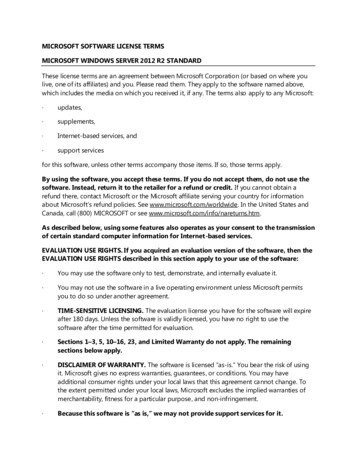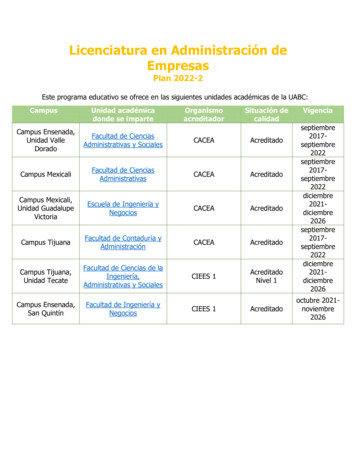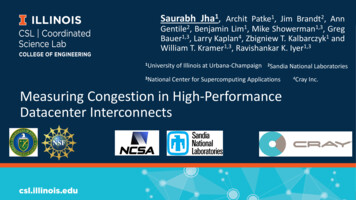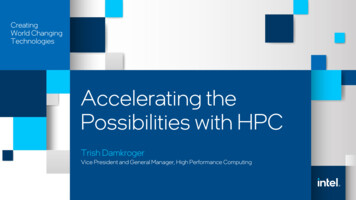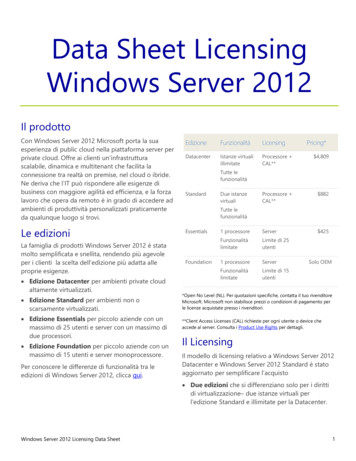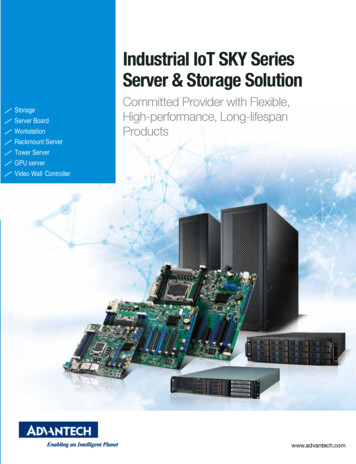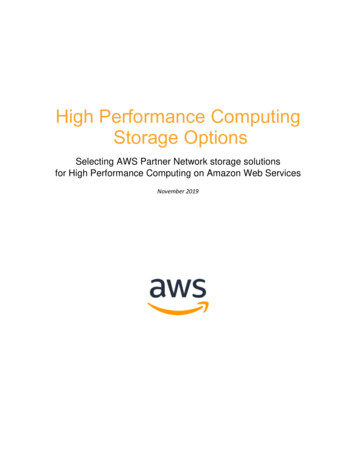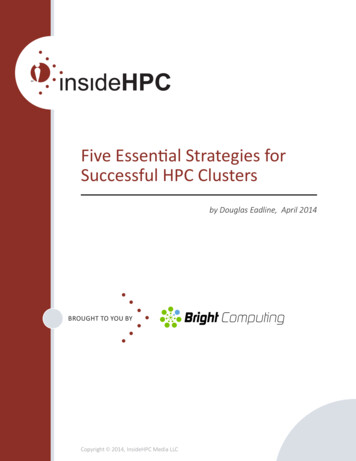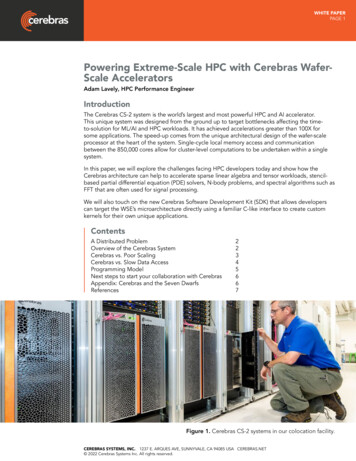
Transcription
WHITE PAPERPAGE 1Powering Extreme-Scale HPC with Cerebras WaferScale AcceleratorsAdam Lavely, HPC Performance EngineerIntroductionThe Cerebras CS-2 system is the world’s largest and most powerful HPC and AI accelerator.This unique system was designed from the ground up to target bottlenecks affecting the timeto-solution for ML/AI and HPC workloads. It has achieved accelerations greater than 100X forsome applications. The speed-up comes from the unique architectural design of the wafer-scaleprocessor at the heart of the system. Single-cycle local memory access and communicationbetween the 850,000 cores allow for cluster-level computations to be undertaken within a singlesystem.In this paper, we will explore the challenges facing HPC developers today and show how theCerebras architecture can help to accelerate sparse linear algebra and tensor workloads, stencilbased partial differential equation (PDE) solvers, N-body problems, and spectral algorithms such asFFT that are often used for signal processing.We will also touch on the new Cerebras Software Development Kit (SDK) that allows developerscan target the WSE’s microarchitecture directly using a familiar C-like interface to create customkernels for their own unique applications.ContentsA Distributed ProblemOverview of the Cerebras SystemCerebras vs. Poor ScalingCerebras vs. Slow Data AccessProgramming ModelNext steps to start your collaboration with CerebrasAppendix: Cerebras and the Seven DwarfsReferences22345667Figure 1. Cerebras CS-2 systems in our colocation facility.CEREBRAS SYSTEMS, INC. 1237 E. ARQUES AVE, SUNNYVALE, CA 94085 USA CEREBRAS.NET 2022 Cerebras Systems Inc. All rights reserved.
WHITE PAPERPAGE 2A Distributed ProblemThere is a growing realization in the highperformance computing (HPC) field that thetraditional scale-out approach – “node-levelheterogeneity” – of hundreds or thousandsof identical compute nodes loaded up withGPUs or other accelerators has limitations. Theefficiency of algorithms tends to decrease asthey are split, or “sharded” across many nodes,because moving data between those nodes issuch a slow process. Writing code for massivelyparallel systems is a specialized skill and is verytime consuming.Figure 2. Trends in the relative performance ofAs John McCalpin from the Texas Advancedfloating-point arithmetic and several classes ofComputing Center famously observed,data access for select HPC servers over the pasttraditional CPUs and GPUs have been improving25 years. Source: John McCalpin.faster than the networks that connect them for1several decades now. Any scaling problemwith conventional hardware now will likely justbe exacerbated with future commodity hardware. For example, if you are constrained by memorybandwidth now, you are likely to continue to be because the trend is for FLOPs to grow at 4.5X thememory bandwidth.System Level HeterogeneityA far better solution is to switch to a completely different architecture and scale up the power ofindividual compute nodes, that is to add very powerful accelerators to the network as complete,independent compute nodes capable of fitting problems of interest within a single chip. The timesaved by keeping communication local to a single node can move many problems from being“communication-bound” – limited by the speed of communication – to being “compute-bound”– limited by the speed of the actual processing elements. This transition allows the computationalresources available to be used efficiently, rather than sitting idle waiting for data to arrive.Additionally, the need to implement elaborate schemes to “hide” communication behind availablecompute evaporates. This simplifies the programming greatly and allows for more time to bespent on compute optimization.Bronis de Supinski, CTO of Lawrence Livermore National Laboratory’s Livermore ComputingCenter, has described this architecture as “system-level heterogeneity”. The Cerebras CS-2system is the world’s most powerful network-attached accelerator.Overview of the Cerebras SystemAs mentioned above, the CS-2 system is very different to a convention HPC cluster, with its racksof identical servers wired up with a network fabric such as Ethernet or InfiniBand (Figure 1).At the heart of the Cerebras CS-2 system is the second-generation Wafer-Scale Engine (WSE-2)The WSE-2 is a massive parallel processor built from a single 300mm wafer. It offers 850,000 cores,optimized for sparse linear algebra with support for FP16, FP32, and INT16 data types. It contains40GB of onboard SRAM divided between its cores, with 220Pb/s of interconnect bandwidth and20PB/s of memory bandwidth. The 40GB of high-speed SRAM is evenly distributed across thewafer, ensuring that each core can access its local memory in a single clock cycle. This is orders ofmagnitude than memory access to off-chip DRAM as found in conventional architectures.CEREBRAS SYSTEMS, INC. 1237 E. ARQUES AVE, SUNNYVALE, CA 94085 USA CEREBRAS.NET 2022 Cerebras Systems Inc. All rights reserved.
WHITE PAPERPAGE 3In the following sections, we shall explore howthe Cerebras architecture can overcome manyof the roadblocks to increasing applicationperformance that challenge traditional HPCclusters. See the appendix for a deeper diveinto the ways that the Cerebras architecture canaccelerate specific classes of algorithms.Cerebras vs. Poor ScalingMany applications have algorithmic scalingissues that arise because of communication.A communication bottleneck often plaguingHPC applications is that which is driven bya local communication, such as with all yournearest neighbors. PDE solvers for highlynon-linear problems, such as computationalfluid dynamics, and stencil-based solvers areoften bottlenecked because of the amountof communication that needs to happenbetween compute units with neighboring meshelements. Another communication bottleneckis found with algorithms that rely on globalcommunication, such as all-to-alls or reductions.This bottleneck often affects applicationsthat rely on spectral algorithms and particlesimulators which require regular communicationbetween all the computing elements.Cerebras WSE-2850,000 coresThe WSE-2 overcomes many communication46,225 mm2 silicon areabottlenecks because of the unique designof the architecture. First, the fabric is built to2.6 trillion transistorsbe high bandwidth and low latency allowing40 GB on-chip memoryfor unparalleled speed for any application.Each core is directly attached to the four20 PB/s memory bandwidthneighboring cores, and messages can be sentbetween them in a single clock cycle. Fine220 Pb/s fabric bandwidthgrained programmability of the routers sendingthe messages also improves communication7nm process technologyefficiency. Rather than consuming processorcycles, each core’s integrated router can beFigure 3. Characteristics of the Cerebraspre-configured with various communicationWSE-2 chip which powers the CS-2 systemcommands to pass data as required withoutintervention. Using the Cerebras SoftwareLanguage, CSL, data can be sent or received between the router and compute element on eachcore without entering memory. This can improve computation speed by saving the cycles requiredto write and then read data back to the processor and can reduce the memory footprint requiredwhich allows for even larger simulations to be undertaken.Applications that can be accelerated due to the high bandwidth and low latency include spectralsolvers and particle simulators that rely on regular all-to-all type communications, and partialdifferential equation (PDE) and iterative solvers for non-linear problems that require regularcommunication between neighboring compute elements.CEREBRAS SYSTEMS, INC. 1237 E. ARQUES AVE, SUNNYVALE, CA 94085 USA CEREBRAS.NET 2022 Cerebras Systems Inc. All rights reserved.
WHITE PAPERPAGE 4An example of the acceleration a CS-2 hasto offer due, in part, to the high bandwidthavailable on the wafer is in the energy industry,where Cerebras has partnered with TotalEnergiesto create a seismic solver that is communicationbound on traditional hardware.2 The Cerebrastechnology allows for speed-ups of over twoorders of magnitude for workflows vital to manyenergy companies. This speed-up comes frombeing able to run at a high compute efficiency,where almost no cycles are spent waiting for datato be transferred. The solver becomes “computebound” when run on the CS-2, a phrase whichis music to the ears of any HPC developer.3A detailed tutorial on the optimized 25-pointstencil application showcasing adaptiverouting and efficient compute methods atthe heart of the solver is available in our SDKdocumentation.At TotalEnergies, one of the largest energycompanies in the world, the CS-2 systemoutperformed a modern AI GPU by morethan 200X on a finite difference seismicmodelling benchmark using code written inthe Cerebras Software Language (CSL).The second way that the Cerebras wafer-scaleLearn more in this blog post2 and thisdesign allows for codes that were previouslyco-authored paper.3communication-bound to accelerate isthe sheer size of the WSE. The WSE-2 has850,000 cores all on the same wafer. While data traversing from one corner diagonally to the othercorner does require roughly 2000 cycles to do all the hops from one PE to a neighbor and on,the 2000 cycles is dwarfed by the amount of time conventional hardware would take to pass dataacross a conventional external network between 850k cores. The communication time incurredduring inter-nodal communication on clusters of conventional hardware with NICs and networksis orders of magnitude slower than the self-contained WSE. The locality of the compute allows forthe reduction of communication time for almost every type of ML or HPC problem.Cerebras vs. Slow Data AccessData access constraints are a bottleneck for many HPC and ML/AI applications. Data accessissues are typically caused by two things: 1) not being able to access new data fast enough, and2) not being able to access the data already loaded in memory quickly. The CS-2 alleviates theseproblems by design, allowing for far fastercomputation than with traditional hardware.The CS-2 system has 1.2 Tb/s of bandwidthonto the system from support nodes using100 Gbps Ethernet connections. This highbandwidth allows for quick loading andunloading of data for applications that arewafer-resident, where all the data lives on thewafer for the duration of the computation.Additionally, data can be streamed onto andoff the wafer quickly as the computation isrunning. This has the potential to allow for realtime analysis of data on large data sets, such asradar or astronomical data, as the data is beingcreated, or can be used to write out checkpointor log files without slowing the computation.Figure 4. Example of system-levelheterogeneity using a Cerebras system inconjunction with the Lassen supercomputerat LLNL.CEREBRAS SYSTEMS, INC. 1237 E. ARQUES AVE, SUNNYVALE, CA 94085 USA CEREBRAS.NET 2022 Cerebras Systems Inc. All rights reserved.
WHITE PAPERPAGE 5The high data transfer rates allow for the waferto be used as a part of complicated workflows.For example, a Cerebras system has beenincorporated in the Lassen supercomputerat the National Ignition Facility at LawrenceLivermore National Laboratory (LLNL).4Lassen runs a physics package called HYDRAwhich models a nuclear fusion reaction, andthe Cerebras system runs a deep neuralnetwork designed to replace a part of thecomputation that models atomic kinetics andradiation (Figure 4). The ML workload can becalled at every time-step of the simulationbeing run on a large supercomputer becauseof the high bandwidth between the waferand the outside compute elements.Learn more about Cerebras and LLNL’swork to blend high performance computingwith artificial intelligence here.4The local memory access speed is one of the most impressive aspects of the design of the WSE.Each core can move data from the private SRAM memory pool to the core’s processor registersin one cycle. This access speed rivals L1 cache speeds on typical multi-core processors, and isthe same for all of the memory on the wafer. Striding or other tricks used to transport data fromL2 cache, or slower off-chip memory, into L1 on conventional hardware are thus not required.Computations that are bound by cache size or cache speed are often sped up by orders ofmagnitude because of the fast access to local memory. Applications that utilize GEMM, GEMV, orsparse matrix operations such as linear algebra solvers, and stencil-based PDE solvers see speedups of several orders of magnitude.An example of how the high Cerebras localmemory access speed can accelerate anapplication is with a computation fluid dynamics(CFD) application developed by the NationalEnergy Technology Laboratory (NETL).5 Thesparse linear equation solver developed byNETL has been shown to accelerate their CFDapplication by 200 X compared with their inhouse Joule 2.0 supercomputer. Additionally, aGEMV implementation can be found within theSDK benchmark suite allowing users to buildtheir own GEMV-based using an optimizedimplementation as a building block towardstheir unique applications.Learn more about Cerebras and NETL’srecord-setting work in computational fluiddynamics here.5Programming ModelWhile the Cerebras Software Platform already supports the PyTorch and TensorFlow frameworks,the Cerebras SDK allows programmers to write lower-level code that targets the WSE’smicroarchitecture directly.6The programmer can write code that targets every core of the wafer such that compute andmemory are optimally utilized. Applications can be programmed with a domain-specificprogramming language called the Cerebras Software Language, or CSL. CSL is similar to C andwill thus familiar to most HPC programmers. CSL was built with ease-of-use in mind. We haveintroduced new, special functionality to easily create code optimized for the wafer while retainingstandard syntax and functionality. A programmer can assign many cores to do the exact samething or give them unique tasks. This flexibility allows for efficient computations by eliminatingCEREBRAS SYSTEMS, INC. 1237 E. ARQUES AVE, SUNNYVALE, CA 94085 USA CEREBRAS.NET 2022 Cerebras Systems Inc. All rights reserved.
WHITE PAPERPAGE 6idle cycles. The programmability of individualcores allows for SIMD, SISD, MISD or MIMDprogramming across any portion of the chip thatis required.The CS-2 system is programmed similarly tomost accelerators today. A host system is usedto load programs on to the CS-2 system forexecution. Additionally, Cerebras has created asimulator which can be targeted rather an actualCS-2 system for porting, testing and debugging.Programs intended for the CS-2 system arewritten in the CSL programming language,which is optimized for dataflow applications. CSLalso allows the developer to specify whichgroups of cores will run which programs.This additional flexibility helps CS-2 systemprogrammers take full advantage of what theplatform has to offer.Learn more about the Cerebras SoftwareDevelopment Kit in this white paper: Cerebras SDK Technical Overview.6Next steps to start your collaboration with CerebrasIf you are curious about programming for wafer-scale or want to evaluate whether the CS-2system would be a good fit for your application, we encourage you to get in touch at http://www.cerebras.net/hpc. If you do, there are a few data points that will help us answer your questionsmost effectively: Let us know what languages and development environments you are familiar with,which libraries you rely on, and the known performance bottlenecks that are holding you back inyour current compute environment.Appendix: Cerebras and the Seven DwarfsIn 2004, Phillip Colella of Berkeley gave a brief presentation called Defining SoftwareRequirements for Scientific Computing where he outlined seven algorithms that were present inmost parallel computing applications. These have come to be affectionately known as the “SevenDwarfs of Symbolic Computation.” This appendix offers a deeper dive into how the Cerebrasarchitecture can accelerate each of these algorithms:1. Sparse Linear AlgebraThe CS-2’s memory access speeds and fabric bandwidth allow for excellent acceleration for typicalsparse linear algebra applications. Having the entirety of memory one cycle from the processorsreduces the time for arbitrary memory access by orders of magnitude, and the communicationbeyond nearest neighbors is able to utilize the on-chip bandwidth rather than do any inter-nodalcommunication.2. Dense Linear AlgebraThe CS-2’s memory access speeds can allow for accelerations of portions of the workflows.Traditional compute hardware may be able to overlap communication and compute for sometypes of problems, not allowing the low-latency, high bandwidth fabric on the wafer to beadvantageous. Applications in which the CS-2 will provide faster time-to-solution than traditionalhardware are those which have greater communication needs.3. Spectral MethodsThe WSE-2’s fabric, size and memory access speeds make the CS-2 an excellent choice formany spectral applications. The all-to-alls and reductions typical of most spectral methods canuse the high-bandwidth and low-latency fabric between the PEs. Furthermore, having access toCEREBRAS SYSTEMS, INC. 1237 E. ARQUES AVE, SUNNYVALE, CA 94085 USA CEREBRAS.NET 2022 Cerebras Systems Inc. All rights reserved.
WHITE PAPERPAGE 7850,000 processing elements without having to incur any sort of off-chip, let alone intra-nodal,communication time hit allows for dramatic acceleration of many applications. Additionally, thememory access speeds allow for high use of the processing elements, with no idle cycles waitingon data that is already in memory to be read into the registers.4. N-body MethodsThe communication pattern required for many N-body methods can utilize the WSE-2 fabric’shigh-bandwidth and low-latency well. The adaptive routing capability can be utilized to haveexcellent performance for any hierarchical-type communication patterns. Additionally, the abilityto read incoming into the registers directly rather than to memory can allow for the compute therequires communicated data to run well. Furthermore, the data that is in memory can be accessedincredibly quickly. The CS-2 is an excellent choice for many N-Body type applications.5. Structured GridsThe CS-2’s fabric, memory access speeds, size and unique architecture can speed up almostevery aspect of typical structured grid problems. The high-bandwidth fabric is useful for allcommunication, especially as stencil sizes grow larger. The adaptive routing can optimizecommunication times, and the ability to read directly from incoming communication to theregisters gives the CS-2 a dramatic boost in speed. Furthermore, the ability to do problems using850,000 cores without any off-chip latency hit is incredibly useful.6. Unstructured GridsThe CS-2 can provide increased performance for some unstructured grid applications. Applicationsthat have complicated meshes typically require multiple levels of memory reference indirection,where data access speeds can dominate time-to solution. These applications can be accelerateddue to the entirety of the local memory only being a single cycle from the registers. Additionally,applications with complex communication patterns will see reduced time-to-completion as thefabric’s bandwidth and latency advantages will reduce communication times.7. Monte CarloTypical Monte Carlo, or embarrassingly parallel, type simulations may see acceleration if there arehigh levels of data movement between the wafer and host system due to the high bandwidth on/off the CS-2 system. Additionally, the high-speed local memory access may provide speed-up forcertain computational kernels being run, and the wafer size of 850,000 cores may provide the rawcompute power necessary for some Monte Carlo applications.References1 Tiffany Trader, “STREAM Benchmark Author McCalpin Traces System Balance Trends”, HPCWire, 2016, -hpc-system-balance-trends/2 Rebecca Lewington, “TotalEnergies and Cerebras: Accelerating into a Multi-Energy Future”,Cerebras, i-energy-future/3Mathias Jacquelin, Mauricio Araya-Polo, Jie Meng, “Massively scalable stencil algorithm”,Submitted to SuperComputing 2022, https://arxiv.org/abs/2204.037754 Lawrence Livermore National Laboratory customer spotlight page national-laboratory/5 Kamil Rocki, Dirk Van Essendelft, Ilya Sharapov, Robert Schreiber, Michael Morrison, VladimirKibardin, Andrey Portnoy, Jean Francois Dietiker, Madhava Syamlal, Michael James, “Fast StencilCode Computation on a Wafer-Scale Processor”, 2020, https://arxiv.org/abs/2010.036606 Justin Selig, “The Cerebras Software Development Kit: A Technical Overview” erebras SDK Technical Overview White Paper.pdfCEREBRAS SYSTEMS, INC. 1237 E. ARQUES AVE, SUNNYVALE, CA 94085 USA CEREBRAS.NET 2022 Cerebras Systems Inc. All rights reserved.
Powering Extreme-Scale HPC with Cerebras Wafer-Scale Accelerators Adam Lavely, HPC Performance Engineer Introduction The Cerebras CS-2 system is the world's largest and most powerful HPC and AI accelerator. This unique system was designed from the ground up to target bottlenecks affecting the time-to-solution for ML/AI and HPC workloads.
